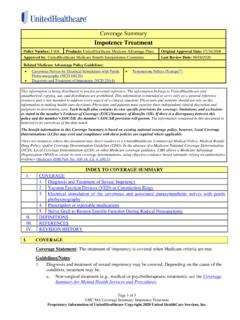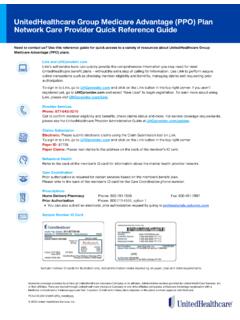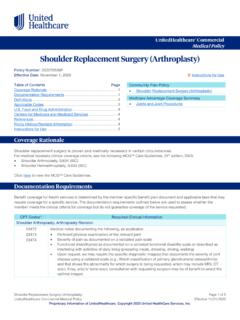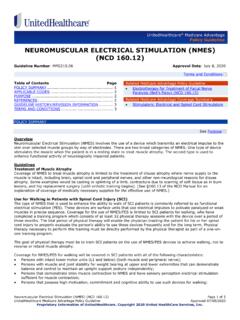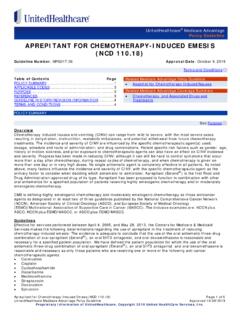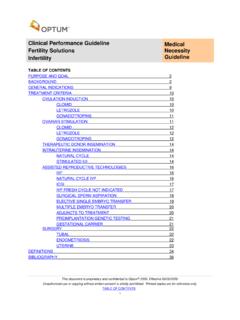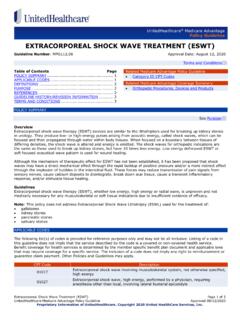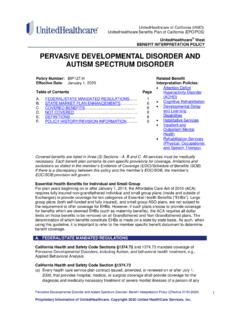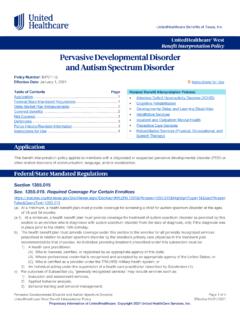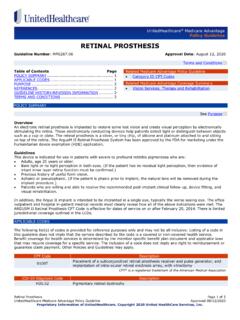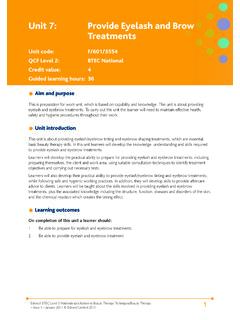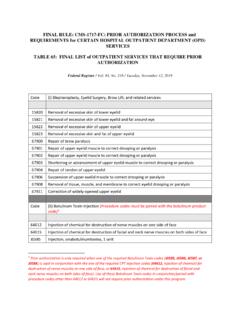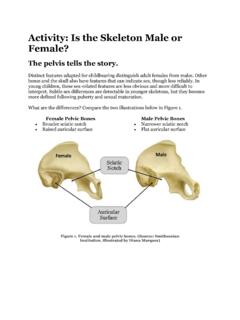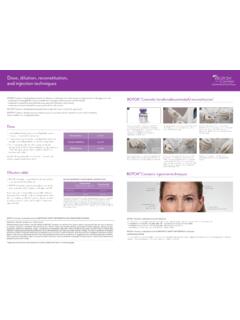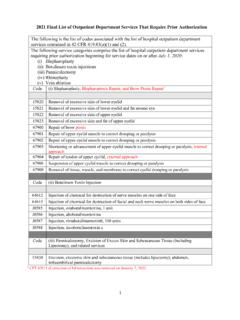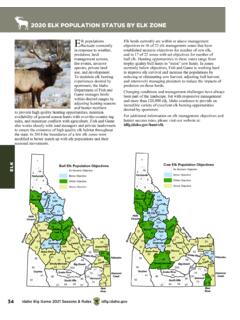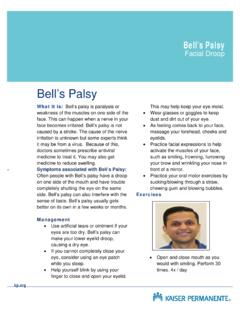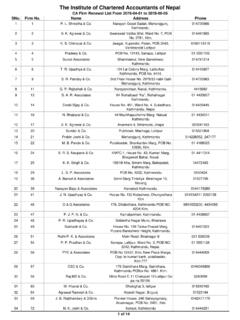Transcription of Blepharoplasty, Blepharoptosis, and Brow Ptosis Repair
1 UnitedHealthcare Commercial Coverage Determination Guideline blepharoplasty , blepharoptosis , and Brow Ptosis Repair Guideline Number: Effective Date: April 1, 2021 Instructions for Use Table of Contents Page Related Commercial Policy Coverage Rationale .. 1 Cosmetic and Reconstructive Procedures Documentation Requirements .. 5. Definitions .. 5 Community Plan Policy Applicable Codes .. 6 blepharoplasty , blepharoptosis , and Brow Ptosis References .. 8 Repair Guideline History/Revision Information .. 8 Medicare Advantage Coverage Summary Instructions for Use .. 8. blepharoplasty and Related Procedures Coverage Rationale Indications for Coverage Some states require benefit coverage for services that UnitedHealthcare considers Cosmetic Procedures, such as Repair of external Congenital Anomalies in the absence of a Functional Impairment.
2 Refer to the member specific benefit plan document. Criteria for a Coverage Determination that Surgery is Reconstructive and Medically Necessary The following must be available when requested by UnitedHealthcare: Best corrected visual acuity in both eyes, all members (except pediatrics). Eye exam (chief complaint, HPI). Clear, high-quality, clinical photographs (eye level, frontal with the member looking straight ahead, light reflex visible and centered). Peripheral or superior Visual Fields automated, reliable, un-taped/taped are preferable o In situations where computerized Reliable Visual Field testing is not available, we will accept manual Reliable Visual Field testing o In situations where Reliable Visual Field testing is not possible, see section below titled When the Member is Not Capable of Reliable Visual Field Testing Note: The Visual Fields and high-quality, clinical photographs must be consistent.
3 If multiple procedures are requested, the following criteria must be met: All criteria for each individual procedure must be met; and Reliable Visual Field testing shows visual impairment which can't be addressed by one procedure alone; and High-quality, clinical photograph findings are consistent with Visual Field findings Upper eyelid blepharoplasty (CPT 15822 and 15823) is considered reconstructive and medically necessary when the following criteria are present: Ptosis has been ruled out as the primary cause of Visual Field obstruction; and Clear, high-quality, clinical photographs must show that the extra skin is the primary cause of Visual Field obstruction; and The member must have a Functional or Physical Impairment complaint directly related to an abnormality of the eyelid(s).
4 And blepharoplasty , blepharoptosis , and Brow Ptosis Repair Page 1 of 9. UnitedHealthcare Commercial Coverage Determination Guideline Effective 04/01/2021. Proprietary Information of UnitedHealthcare. Copyright 2021 United HealthCare Services, Inc. Excess skin (dermatochalasis/blepharochalasis) touches the lashes; and Automated peripheral or superior Reliable Visual Field testing, with the eyelid skin taped and un-taped, showing improvement of 30% (or 12 degrees) or more. o In situations where computerized Reliable Visual Field testing is not available, we will accept manual Reliable Visual Field testing o In situations where Reliable Visual Field testing is not possible, see section below titled When the Member is Not Capable of Reliable Visual Field Testing Note: Extended blepharoplasty may be indicated for blepharospasm (eyelids are forced shut) when the following two criteria are met: Debilitating symptoms ( , pain); and Conservative treatment has been tried and failed, or is contraindicated ( , Botox ).
5 Upper eyelid blepharoptosis Repair (CPT 67901 67909) is considered reconstructive and medically necessary when the following criteria are present: The member must have a Functional or Physical Impairment complaint directly related to the position of the eyelid(s); and Other treatable causes of Ptosis are ruled out ( , recent Botox injections, myasthenia gravis when applicable); and Eyelid droop (upper eyelid Ptosis ) and a Marginal Reflex Distance -1 (MRD-1) of mm or less; and The MRD is documented in clear, high-quality, clinical photographs with the member looking straight ahead and light reflex centered on the pupil; and Automated peripheral or superior Reliable Visual Field testing, with the eyelids taped and un-taped, showing improvement of 30% (or 12 degrees) or more improvement in the number of points seen o In situations where computerized Reliable Visual Field testing is not available, we will accept manual Reliable Visual Field testing o In situations where Reliable Visual Field testing is not possible, see section below titled When the Member is Not Capable of Reliable Visual Field Testing Note: For children under age 10 years, Ptosis Repair is covered to prevent amblyopia.
6 Reliable Visual Field testing is not required, but high-quality, clinical photographs are required. Brow Ptosis (CPT 67900) is considered reconstructive and medically necessary when the following criteria are present: Other causes have been eliminated as the primary cause for the Visual Field obstruction ( , Botox treatments within the past six (6) months); and The member must have a functional complaint related to brow Ptosis . Brow Ptosis must be documented in two high-quality, clinical photographs. One showing the eyebrow below the bony superior orbital rim, and a second photograph with the brow elevated that eliminates the Visual Field defect; and o Automated peripheral and superior Reliable Visual Field testing, with differential taping (eyebrow and eyebrow + eyelid).
7 Showing 30% (or 12 degrees) or more improvement in total number of points seen with the eyebrow taped up. In situations where computerized Reliable Visual Field testing is not available, we will accept manual Reliable Visual Field testing o In situations where Reliable Visual Field testing is not possible, see section below titled When the Member is Not Capable of Reliable Visual Field Testing Documentation indicating the specific brow lift procedure ( , supra-ciliary, mid forehead or coronal, pretrichial, direct brow lift vs browpexy, internal brow lift). Brow Ptosis Repair (CPT 67900) as an adjunct to upper eyelid blepharoplasty (CPT 15822 and 15823) is considered reconstructive and medically necessary when the criteria for each separate service are met (as per above) and: Automated peripheral and superior Reliable Visual Field testing demonstrates the following: o Differential taping showing 30% (or 12 degrees) or more improvement in total number of points seen with the eyelid taped up and an additional 30% (or 12 degrees) or more improvement in total number of points seen with the eyelid +.
8 Eyebrow taped up, confirming the contribution of brow Ptosis to visual field obstruction Note: For Browpexy/internal brow lift, see Coverage Limitations and Exclusions. blepharoplasty , blepharoptosis , and Brow Ptosis Repair Page 2 of 9. UnitedHealthcare Commercial Coverage Determination Guideline Effective 04/01/2021. Proprietary Information of UnitedHealthcare. Copyright 2021 United HealthCare Services, Inc. Eyelid surgery for correction of lagophthalmos is considered reconstructive and medically necessary when the upper eyelid is not providing complete closure to the eye, resulting in dryness and other complications. Eyelid surgery with an anophthalmic socket (has no eyeball) is considered reconstructive and medically necessary when both of the following criteria are present: The member has an anophthalmic condition; and The member is experiencing difficulties fitting or wearing an ocular prosthesis.
9 Lower eyelid blepharoplasty (CPT 15820 and 15821) is usually cosmetic, however, is considered reconstructive and medically necessary only when all of the following criteria are present: There is documented facial nerve damage; and Clear, high-quality, clinical photographs document the pathology; and The member is unable to close the eye due to the lower lid dysfunction; and Functional Impairment including both of the following: o Documented uncontrolled tearing or irritation; and o Conservative treatments tried and failed Ectropion (eyelid turned outward) (CPT 67914 through 67917) or punctal eversion is considered reconstructive and medically necessary when all of the following criteria are present: Clear, high-quality, clinical photographs document the pathology; and Corneal or conjunctival injury with both of the following criteria: o Subjective symptoms include either: Pain or discomfort; or Excess tearing; and o Any one of the following: Exposure keratitis; and/or Keratoconjunctivitis.
10 And/or Corneal ulcer Entropion (eyelid turned inward) (CPT 67921 67924) is considered reconstructive and medically necessary when all of the following criteria are present: Clear, high-quality, clinical photographs must document the following: o Lid turned inward; and o At least one of the following: Trichiasis; or Irritation of cornea or conjunctiva; and o Subjective symptoms including either of the following: Excessive tearing; or Pain or discomfort Lid retraction surgery (CPT 67911) is considered reconstructive and medically necessary when all of the following criteria are present: Other causes have been eliminated as the reason for the lid retraction such as use of dilating eye drops, glaucoma medications; and Clear, high-quality, clinical photographs document the pathology; and There is Functional Impairment (such as dry eyes', pain/discomfort, tearing, blurred vision); and Tried and failed conservative treatments.
